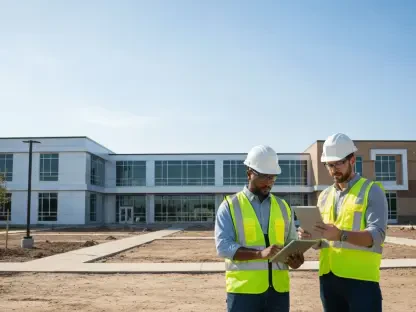In an era of mounting financial constraints and pressing societal demands, public institutions across the United States are increasingly embracing public-private partnerships (P3s) as a transformative approach to infrastructure development. These collaborative agreements between public entities and private sector partners are proving to be a lifeline for delivering essential projects such as housing, transportation, and educational facilities, especially when traditional funding models fall short. A recent report by Jones Lang LaSalle (JLL), titled “Redefining Public Delivery One P3 at a Time,” sheds light on the remarkable surge in P3 implementation, analyzing 58 facility-focused transactions from 2019 to 2024. This period witnessed 41 social infrastructure projects closing between 2022 and 2024, more than doubling the 17 contracts signed in the preceding three years. This rapid growth signals a profound shift in how public needs are met, driven by economic challenges like rising interest rates that push institutions to seek innovative financing solutions while sharing risks with private partners. As P3s evolve from a niche strategy to a mainstream tool, their impact on diverse sectors and regions offers a compelling story of adaptation and resilience.
Drivers Behind P3 Adoption
Financial and Economic Pressures
The escalating cost of borrowing has become a significant catalyst for the adoption of P3s among public institutions facing tighter budgets and macroeconomic uncertainty. With interest rates climbing in recent years, the gap between public and private capital costs has widened, compelling public entities to rethink traditional financing approaches. Unlike earlier periods when low rates aligned borrowing costs, today’s environment often requires public bodies to assume greater financial risks or provide guarantees to ensure project viability. This shift reflects a more sophisticated approach to risk-sharing, where P3 agreements are tailored to balance the burden between partners. The flexibility of these partnerships allows public institutions to move forward with critical infrastructure projects without overextending limited resources, addressing urgent needs in a landscape where fiscal prudence is paramount. This adaptation underscores the growing reliance on private sector expertise to navigate economic headwinds effectively.
Beyond the challenge of rising costs, budget constraints have further accelerated the turn toward P3s as a practical solution for infrastructure delivery. Public institutions, grappling with limited funds, find it increasingly difficult to rely solely on taxpayer money or municipal bonds to finance large-scale projects. P3s offer an alternative by tapping into private capital, enabling the development of essential facilities like schools and transportation hubs without straining public coffers. This model not only alleviates immediate financial pressures but also allows for long-term planning by spreading costs over extended periods through structured agreements. The economic volatility of recent times has only heightened the appeal of such partnerships, as they provide a buffer against unpredictable market shifts. By leveraging private investment, public entities can maintain focus on strategic priorities while ensuring that infrastructure keeps pace with societal demands, highlighting the critical role of P3s in sustaining public services under fiscal duress.
Legislative and Market Dynamics
Legislative frameworks have emerged as a powerful driver in shaping the landscape of P3 adoption across various regions. States with supportive policies create an environment where public institutions feel empowered to engage in these partnerships, knowing that legal and regulatory hurdles are minimized. This enabling atmosphere often translates into streamlined approval processes and clearer guidelines for risk allocation, making P3s a more attractive option for addressing infrastructure gaps. Maryland serves as a prime example, where favorable legislation has propelled P3 activity in sectors like K-12 education despite a smaller population base. Such policies act as a blueprint for other regions, demonstrating that intentional governmental support can significantly influence the pace and scale of partnership initiatives. The interplay between law and market readiness illustrates how systemic changes can unlock the potential of P3s to meet public needs efficiently.
Market dynamics, particularly in rapidly growing areas, also play a crucial role in driving the uptake of P3s among public entities. Suburban regions near major metropolitan centers, such as those surrounding Austin, Texas, are experiencing population booms that strain existing infrastructure. Local governments in these areas often lack the immediate capital to address aging systems or build new facilities, turning to P3s as a means to bridge the funding gap. These partnerships enable the rapid deployment of projects tailored to specific community needs, from upgraded utilities to expanded public services, ensuring that growth does not outpace capacity. The private sector’s ability to bring efficiency and innovation to the table further enhances the appeal of P3s in such dynamic markets. As urban sprawl continues to reshape demographic patterns, the demand for scalable solutions through these collaborations is likely to intensify, positioning P3s as a cornerstone of modern infrastructure planning in high-growth zones.
Key Sectors and Applications
Higher Education as a Priority
Higher education has emerged as a dominant arena for P3 activity, with student housing needs driving a significant portion of these partnerships over the past few years. Accounting for over 50% of P3 projects since 2019, this sector has prioritized new construction, with 80% of initiatives focusing on building rather than renovating existing facilities. A notable case is Purdue University’s project in Fort Wayne, Indiana, which delivered 602 new beds through a tax-exempt P3 model, striking a balance between affordability and campus expansion. This focus on housing reflects the urgent demand for modern accommodations as institutions compete to attract students in a competitive academic landscape. By partnering with private entities, universities can address these needs without diverting funds from core educational programs, ensuring that infrastructure keeps pace with enrollment trends. The success of such projects highlights how targeted P3 applications can transform institutional capabilities.
The strategic value of P3s in higher education extends beyond physical infrastructure to measurable outcomes like enrollment growth. Public four-year colleges leveraging these partnerships reported a 7% increase in student numbers from 2019 to 2024, a stark contrast to a national decline of 1.3% among similar institutions not using P3s. This growth suggests that modern facilities, often funded through such collaborations, play a critical role in attracting and retaining students. Enhanced campus environments, including state-of-the-art housing and amenities, signal to prospective students a commitment to quality and innovation. Furthermore, P3s allow universities to manage financial risks associated with large capital projects, freeing up resources for academic investments. This dual benefit of infrastructure improvement and institutional vitality underscores why higher education remains a cornerstone of P3 activity, setting a precedent for how strategic partnerships can yield long-term advantages in competitive sectors.
Diversification Across Asset Classes
While higher education leads P3 engagement, the model’s versatility is evident in its expansion into a broader array of asset classes addressing varied public priorities. Beyond student housing, P3s are making inroads into energy resilience projects, workforce housing initiatives, and public transportation systems. Emerging sectors such as healthcare and media are also beginning to explore these partnerships, recognizing their potential to fund specialized facilities that meet modern demands. Energy infrastructure, for instance, is gaining traction as public institutions seek sustainable solutions to power growing communities, often through private investment in renewable projects. This diversification signals a maturing of the P3 model, moving from traditional applications to innovative areas that align with contemporary challenges like climate change and urbanization. The ability to adapt to such a wide range of needs positions P3s as a flexible tool in the public sector’s arsenal for future planning.
Local government needs, particularly in expanding suburban markets, further illustrate the adaptability of P3s in addressing infrastructure strained by demographic shifts. Areas near major cities, experiencing rapid population growth, often face challenges with outdated utilities, roads, and public amenities. P3s provide a mechanism to modernize these systems without the immediate burden of full public funding. For instance, communities in the outskirts of bustling urban centers are partnering with private entities to develop everything from water treatment plants to transit hubs, ensuring that growth does not compromise quality of life. The private sector’s involvement often brings efficiencies in project delivery and cost management, which are critical for cash-strapped municipalities. This application of P3s to localized, community-specific challenges demonstrates their scalability, offering tailored solutions that can be replicated across diverse regions facing similar pressures from population influxes and urban expansion.
Geographic and Policy Influences
Regional Concentrations
Geographic patterns reveal a concentrated hub of P3 activity in just five states—California, Maryland, New York, Pennsylvania, and Florida—where population size and infrastructure demands drive engagement. These states account for the majority of P3 deals, reflecting a correlation between demographic scale and the need for innovative delivery models. Asset types vary distinctly by region, with California leading in higher education projects, while New York focuses heavily on transportation and aviation infrastructure. This regional disparity highlights how local priorities shape the application of P3s, with larger populations often necessitating a broader range of projects to address diverse public needs. The concentration in these states also suggests that economic and social complexities in densely populated areas create fertile ground for partnerships that can tackle multifaceted challenges, positioning these regions as trendsetters in the P3 landscape.
The dominance of specific states in P3 activity also points to the role of established networks and expertise in sustaining momentum for these partnerships. In areas like California and New York, a history of successful P3 projects has built a foundation of trust and knowledge among public and private stakeholders, facilitating smoother deal closures. This experience translates into more ambitious projects, as seen in California’s extensive focus on university housing and New York’s large-scale transit initiatives. Furthermore, the concentration of activity fosters a competitive environment where innovation in P3 structures—such as creative financing or risk-sharing models—becomes a norm rather than an exception. While this regional focus drives significant progress, it also underscores a disparity in P3 adoption nationwide, raising questions about how less active states might replicate these successes. The lessons from leading regions could serve as a roadmap for expanding P3 benefits to underrepresented areas.
Policy as a Catalyst
Supportive policy environments stand out as a critical factor in amplifying P3 adoption, with certain states demonstrating how legislation can level the playing field. Maryland, despite its smaller population compared to other leading states, has emerged as a frontrunner in P3 activity due to regulatory frameworks that encourage partnerships in sectors like K-12 education and local government. These policies streamline processes, clarify risk allocation, and provide incentives that make P3s an attractive option for public entities. The result is a higher rate of project initiation and completion, even in regions without the demographic scale of larger states. This example illustrates that intentional governmental support can significantly influence the pace of P3 implementation, offering a replicable model for other states looking to harness the benefits of such collaborations to address infrastructure gaps effectively.
Beyond individual state policies, the broader implications of legislative support highlight a need for cohesive national guidelines to further P3 growth. While states like Maryland showcase the power of localized frameworks, the lack of uniform standards across the country can create inefficiencies or hesitancy in regions less familiar with P3 structures. Public institutions in states without clear enabling laws often face bureaucratic delays or uncertainty in structuring deals, slowing the adoption of this delivery model. Advocating for federal-level guidance or best practices could help bridge this gap, ensuring that the advantages of P3s—such as accelerated project timelines and shared financial burdens—are accessible to a wider range of communities. As policy continues to evolve, its role in shaping the future trajectory of P3s remains undeniable, with potential to transform how public infrastructure is envisioned and executed in diverse geographic contexts.
Shaping Future Infrastructure Strategies
Reflecting on the remarkable rise of P3s, the period from 2019 to 2024 marked a turning point for public institutions navigating financial and demographic challenges. The doubling of social infrastructure projects in just a few years demonstrated a growing confidence in this model to deliver results where traditional methods faltered. Economic pressures, coupled with the urgent need for modern facilities, spurred innovative risk-sharing and financing approaches that redefined public delivery. Looking ahead, the focus should shift to scaling these successes by fostering broader policy support across states, ensuring that even smaller or less experienced regions can tap into P3 benefits. Encouraging knowledge-sharing from leading states and exploring federal incentives could democratize access to this powerful tool. Additionally, prioritizing emerging sectors like energy resilience and affordable housing in future P3 strategies will address pressing societal needs, paving the way for sustainable growth in an increasingly complex landscape.









